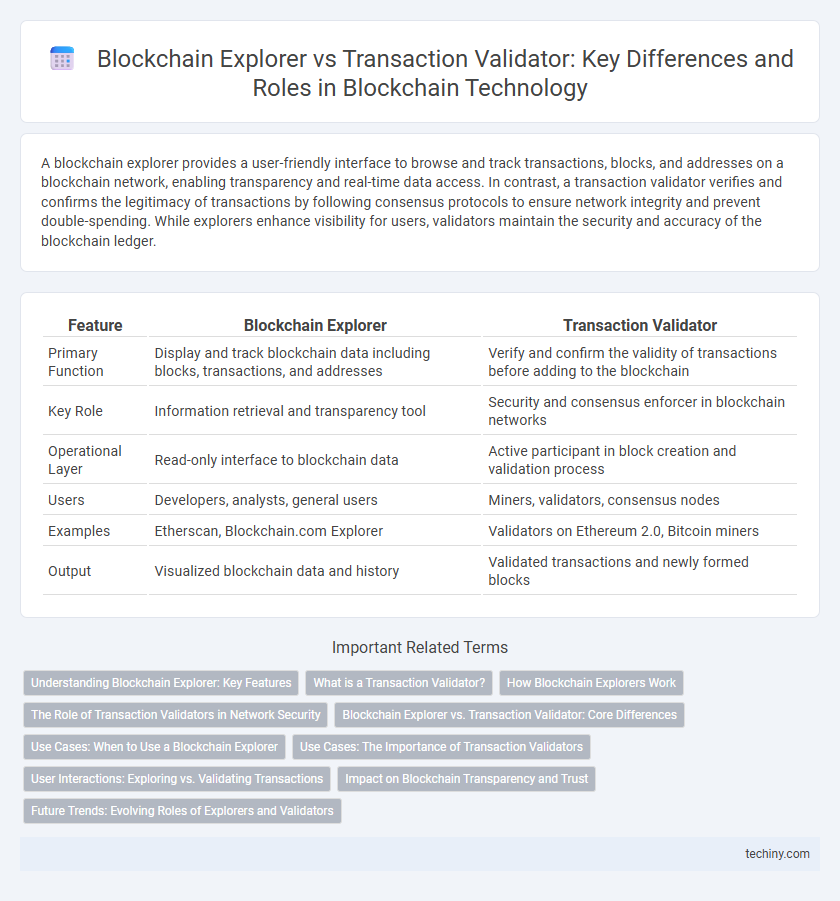A blockchain explorer provides a user-friendly interface to browse and track transactions, blocks, and addresses on a blockchain network, enabling transparency and real-time data access. In contrast, a transaction validator verifies and confirms the legitimacy of transactions by following consensus protocols to ensure network integrity and prevent double-spending. While explorers enhance visibility for users, validators maintain the security and accuracy of the blockchain ledger.
Table of Comparison
| Feature | Blockchain Explorer | Transaction Validator |
|---|---|---|
| Primary Function | Display and track blockchain data including blocks, transactions, and addresses | Verify and confirm the validity of transactions before adding to the blockchain |
| Key Role | Information retrieval and transparency tool | Security and consensus enforcer in blockchain networks |
| Operational Layer | Read-only interface to blockchain data | Active participant in block creation and validation process |
| Users | Developers, analysts, general users | Miners, validators, consensus nodes |
| Examples | Etherscan, Blockchain.com Explorer | Validators on Ethereum 2.0, Bitcoin miners |
| Output | Visualized blockchain data and history | Validated transactions and newly formed blocks |
Understanding Blockchain Explorer: Key Features
Blockchain explorers provide real-time access to transaction histories, block data, and wallet information, enabling users to trace asset movements and verify transaction confirmations. Key features include detailed block summaries, transaction status updates, and address balances, which enhance transparency and facilitate auditing on decentralized networks. Unlike transaction validators that confirm and append transactions to the blockchain, explorers act as analytical tools that offer visibility into blockchain activity without altering consensus.
What is a Transaction Validator?
A transaction validator is a crucial component in blockchain networks responsible for verifying the authenticity and integrity of transactions before they are added to the blockchain ledger. It ensures that the transaction adheres to consensus rules, preventing double-spending and fraudulent activities by confirming that the digital signatures and inputs are valid. Unlike a blockchain explorer, which allows users to view and track transaction histories and block information, a transaction validator actively participates in the consensus process to maintain the network's security and reliability.
How Blockchain Explorers Work
Blockchain explorers retrieve and index blockchain data by scanning each new block added to the chain, allowing users to access detailed transaction histories, wallet addresses, and smart contract interactions in real time. These tools parse blockchain nodes' raw data through APIs, creating searchable databases that facilitate transparency and verification for users. Unlike transaction validators, which confirm and record transactions in new blocks, explorers provide an interface to explore confirmed data and analyze blockchain activity efficiently.
The Role of Transaction Validators in Network Security
Transaction validators play a crucial role in network security by verifying the authenticity and accuracy of blockchain transactions before they are added to the ledger. Unlike blockchain explorers, which provide a user-friendly interface to track and view transaction records and blocks, validators utilize consensus algorithms to confirm transaction legitimacy and prevent double-spending or fraudulent activities. This validation process ensures the integrity, decentralization, and trustworthiness of the blockchain network.
Blockchain Explorer vs. Transaction Validator: Core Differences
Blockchain explorers provide a user-friendly interface to search, analyze, and visualize transaction histories and block details on a blockchain network. Transaction validators, often nodes or miners, authenticate and confirm transactions by ensuring they comply with consensus rules before adding them to the blockchain. While explorers serve as informative tools for transparency and tracking, validators perform the critical function of maintaining blockchain integrity and security.
Use Cases: When to Use a Blockchain Explorer
A blockchain explorer is ideal for users needing to track transaction histories, verify transaction statuses, and analyze block data in real time, providing transparency and auditability on public ledgers. In contrast, a transaction validator plays a crucial role during the transaction process by confirming validity and preventing double-spending within consensus mechanisms. Use a blockchain explorer when monitoring confirmed transactions, researching wallet addresses, or investigating blockchain activity for compliance and forensic purposes.
Use Cases: The Importance of Transaction Validators
Transaction validators are crucial in blockchain networks for maintaining security and consensus by verifying the legitimacy of transactions before they are added to the ledger. Blockchain explorers offer transparency by allowing users to track and analyze confirmed transactions and blocks but do not participate in the transaction validation process. The use case of transaction validators centers on preventing double-spending, ensuring network integrity, and enabling trustless asset transfers, making them indispensable for blockchain functionality.
User Interactions: Exploring vs. Validating Transactions
Blockchain explorers provide users with a graphical interface to search, view, and analyze transaction histories, wallet addresses, and block details, enhancing transparency and ease of access. Transaction validators focus on confirming the authenticity and integrity of transactions through consensus mechanisms, without direct user interaction. While explorers facilitate user engagement by displaying real-time blockchain data, validators operate behind the scenes to ensure secure and accurate transaction processing.
Impact on Blockchain Transparency and Trust
Blockchain explorers enhance transparency by providing real-time access to transaction histories and block details, enabling users to independently verify data on the blockchain. Transaction validators play a crucial role in maintaining trust by confirming the authenticity and correctness of transactions through consensus mechanisms, thereby securing the network against fraud and double-spending. Together, explorers and validators contribute to a transparent and trustworthy blockchain environment by ensuring data accessibility and integrity.
Future Trends: Evolving Roles of Explorers and Validators
Blockchain explorers will increasingly integrate advanced analytics and real-time data visualization tools to enhance transparency and user interaction, bridging the gap between raw blockchain data and actionable insights. Transaction validators are expected to adopt more sophisticated consensus mechanisms and AI-driven verification processes to improve efficiency, security, and scalability in decentralized networks. Emerging trends indicate a convergence where explorers might incorporate validation features, while validators provide more accessible data interfaces, reflecting a future of hybrid roles optimizing blockchain ecosystem functionality.
Blockchain explorer vs Transaction validator Infographic

 techiny.com
techiny.com